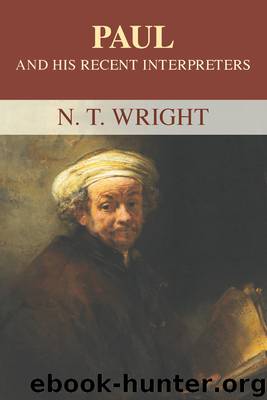Paul and his Recent Interpreters: by N.T Wright

Author:N.T Wright
Format: epub
Publisher: Perseus Books, LLC
1 See the complicated little discussion in Ziegler 2011, 420. The world of scholarship was saddened to hear of Martyn’s death, in his 90th year, in June 2015.
2 Martyn 2012.
3 See esp. Gaventa 2007; and e.g. Gaventa 2011 (a revised form was subsequently published as Gaventa 2012), 2013b, 2013c.
4 See Fortna and Gaventa 1990.
5 See too de Boer’s article in the other Martyn Festschrift (de Boer 1989), which repeats and expands some of the key arguments.
6 cf. Koch 1972 [1970], 123: ‘It is hard to detect any study of the primary texts, at least in continental theology.’
7 de Boer 1988, 7. References in what follows are to this work unless otherwise indicated.
8 de Boer 19, 40.
9 de Boer, 19.
10 e.g. 4 Ez. 6.9; 7.12f., 113; 8.1, 52; 2 Bar. 44.15; 48.50; 73.5. The relevant phrases themselves are not found in Daniel, but the idea of a present time of oppression and wickedness, to be followed eventually by ‘the time of the end’ when God will establish his kingdom, runs throughout much of the book: e.g. 2.36–45; 7.9–14, 21f., 23–7; 8.13f., 17, 19; 9.24–7; 12.1–4.
11 See NTPG 197–9; and the recent brief but helpful survey of Schiffman 2010.
12 It is of course quite possible that some Jews – perhaps the Sadducees are the most likely contenders – would have regarded two-age speculations as dangerous or unnecessary. For the phenomenon, see e.g. mBer. 1.5; mPe’ah 1.1; mKid. 4.14; mB.M. 2.11; mSanh. 10.1–4; mAb. 2.7; 4.1, 16f.; 5.19; and the classic discussions in e.g. Moore 1927–30, 377–95; Schürer 1973–87, 2.537f. See too e.g. Davies 1980 [1948], 287f., with more refs. including the collection of passages in Strack and Billerbeck, 1926–61, 4.816f. The rabbis discussed subtle possible distinctions between ‘the age to come’ and ‘the messianic age’ (a distinction which may find an advance echo in 1 Cor. 15.24–8), but this is beside our present point.
13 de Boer 30 notes that Käsemann expands his definition of ‘apocalyptic’ to include these elements.
14 See Perspectives 520f.
15 de Boer 85 more or less admits that he is omitting much relevant material.
16 de Boer 1989, 173.
17 See Koch 29, 33, 40f. 43, 51f., 84. I have argued the point from the actual texts in PFG 121–8. Koch’s point is well taken (51f.): on the one hand, the apocalyptists stress ‘the divine direction of the whole of history’ (Koch puts the whole phrase into italics); on the other hand, the glorious future which will come at the end of this history ‘does not issue from human energy [nor, we might add, from an immanent process] but from God’s conferring grace.’ If this balance had been maintained a lot of trouble might have been avoided.
18 e. g. Harink and Campbell: see below.
19 de Boer 35–7. In his commentary, however, de Boer (2011, 31) allows that at least in 2 Bar. 56 the wicked angels put in an appearance.
20 de Boer 52f.
21 de Boer 56.
22 de Boer 57.
23 de Boer 58: exclamation original.
24 See Moore 1927–30, 1.453–6, etc. De Boer’s own textual analyses indicate the ease with which these antinomies could be held together: see, e.
Download
This site does not store any files on its server. We only index and link to content provided by other sites. Please contact the content providers to delete copyright contents if any and email us, we'll remove relevant links or contents immediately.
Plagued by Fire by Paul Hendrickson(17117)
The 5 Love Languages: The Secret to Love That Lasts by Gary Chapman(9293)
How to Bang a Billionaire by Alexis Hall(7938)
Wonder by R. J. Palacio(7747)
The Institute by Stephen King(6807)
The Space Between by Michelle L. Teichman(6579)
The Testaments by Margaret Atwood(6520)
The Thirst by Nesbo Jo(6444)
Assassin’s Fate by Robin Hobb(5859)
Wiseguy by Nicholas Pileggi(5324)
The Night Circus by Erin Morgenstern(5041)
Spare by Prince Harry The Duke of Sussex(4799)
Bittersweet (True North #1) by Sarina Bowen(4719)
The MacArthur Bible Commentary by John MacArthur(4656)
The Templars by Dan Jones(4561)
Everything Happens for a Reason by Kate Bowler(4480)
Tuesdays with Morrie by Mitch Albom(4411)
Gerald's Game by Stephen King(4380)
Royally Matched (Royally Series) by Emma Chase(4205)
